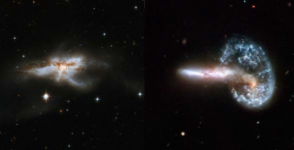The Great Observatories All-sky LIRG Survey: The era of JWST

The Great Observatories All-sky LIRG Survey (GOALS), is combining imaging and spectroscopic data from NASA's Spitzer, Hubble, Chandra and GALEX space-borne observatories in a comprehensive study of over 200 of the most luminous infrared-selected galaxies in the local Universe. The sample consists of approximately 180 Luminous Infrared Galaxies (LIRGs), which are systems with total infrared emission brighter than 1011 L☉ and less than 1012 L☉, as well as over 20 Ultra-Luminous Infrared Galaxies (ULIRGs) with luminosity of 1012 L☉ or greater. The objects are a complete subset of the IRAS Revised Bright Galaxy Sample (RBGS), which comprises 629 extragalactic objects with 60-micron flux densities above 5.24 Jy and Galactic latitude above five degrees. The RBGS objects, all with redshifts, z < 0.088, are the brightest 60-micron sources in the extragalactic sky. The LIRGs and ULIRGs targeted in GOALS span the full range of nuclear spectral types (type-1 and type-2 AGN, LINERs, and starbursts) and interaction stages (major mergers, minor mergers, and isolated galaxies). They provide an unbiased picture of the processes responsible for enhanced infrared emission in the local Universe, and are excellent analogs for comparisons with infrared and sub-millimeter selected galaxies at high-redshift.
Ongoing work on the project, lead by Prof. Vassilis Charmandaris and Dr. Tanio Diaz Santos involves observations of GOALS galaxies using Early Release Science observations with the James Web Space Telescope, as well as the development of sophisticated spectral energy distribution models in order to understand the details of the energy production in these unique systems.
